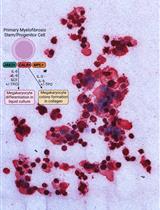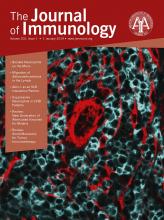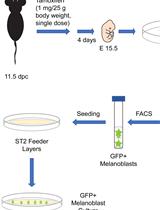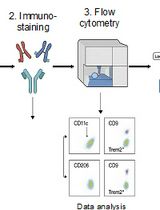- EN - English
- CN - 中文
In vitro Infection of Primary Human Monocytes with HIV-1
原代人单核细胞的体外HIV-1侵染
发布: 2019年07月05日第9卷第13期 DOI: 10.21769/BioProtoc.3289 浏览次数: 5948
评审: Lokesh KalekarPooja SaxenaAnonymous reviewer(s)

相关实验方案

来自骨髓增生性肿瘤患者的造血祖细胞的血小板生成素不依赖性巨核细胞分化
Chloe A. L. Thompson-Peach [...] Daniel Thomas
2023年01月20日 2299 阅读
Abstract
Monocyte infection by HIV-1 is an important component of chronic HIV pathogenesis. Following infection by HIV-1, monocytes are able to cross the blood brain barrier and set up a viral reservoir in the central nervous system. Additionally, in the setting of chronic HIV-1 infection, monocytes can become activated either directly through HIV-1 infection or indirectly via HIV-1-mediated systemic immune activation. Currently, there are few studies looking at HIV-1 infection of primary human monocytes in vitro. Furthermore, detection of successful HIV-1 infection of monocytes can be laborious requiring an ELISA for p24 or assessing levels of HIV-1 mRNA or DNA. This protocol utilizes an HIV-1 strain expressing GFP to allow for easy quantification of HIV-1 infection by fluorescence-assisted cell sorting (FACS). By determining HIV-1 infection by FACS one can take advantage of its multiparametric nature allowing for the use of less cells and the ability to assess the expression of other markers on HIV-1+ and HIV-1- cells in the same experiment. Additionally, this protocol could be modified to study HIV-1 infection of other cells including CD4+ T cells.
Keywords: Monocytes (单核细胞)Background
This protocol will be of use to those looking to perform studies assessing the role that myeloid cells play in HIV-1 infection. Myeloid cells, in particular, monocytes, have been recognized as crucial mediators of chronic and acute inflammation in HIV-1 infection (Burdo et al., 2013; Anzinger et al., 2014; Merino et al., 2017). Gaining a deeper understanding of the interactions between the HIV-1 virus and monocytes will be fundamental in advancing our knowledge on how HIV-1 infection produces a chronic state of immune activation, even in the presence of combined anti-retroviral therapy (Anzinger et al., 2014). With persons infected by HIV-1 now exhibiting lower death rates, we are just now seeing the long-term effects of HIV-1-induced chronic immune activation which can present as: HIV-associated neurocognitive disorder (HAND), hepatic steatosis, renal failure, hepatitis, atherosclerosis, insulin resistance, osteoporosis, and more (Cardoso et al., 2013; Katlama et al., 2013).
The method presented here will be useful to both study how HIV-1 infection of monocytes alters cellular function, and to facilitate the development of novel methods to modulate or prevent HIV-1 infection of monocytes. In particular, this protocol is advantageous in that it allows for quick and easy analysis of monocyte HIV-1 infection using FACS without the need to intracellular stain for p24.
Materials and Reagents
- LS columns (Miltenyi Biotec, catalog number: 130-042-401)
- Glass Pasteur pipettes, autoclaved (VWR, catalog number: 14672-200)
- Aspirating bulb for use with Pasteur pipet (CELLTREAT Scientific Products, catalog number: 229279)
- 50 ml conical tubes (Corning, catalog number: 430290)
- Serological pipettes (Costar)
- 1 ml micropipette
- 96-well high-binding plates (Corning, catalog number: 3361)
- Pipette tips
- pNL-BaL-GFP recombinant HIV-1 virus
Construction of pNL-BaL-GFP HIV-1 vector. The pNL4-3env(-)GFP, which encodes full-length NL4-3 HIV-1 proviral DNA with a frameshift in env and expresses GFP in place of nef, was described previously (He et al., 1997). The CCR5-tropic HIV-1 proviral clone, R9BaL, was generated from R9 by replacing an EcoRI-XhoI fragment from the CCR5-tropic HIV-1 strain, BaL, which contains the entire env coding region (Gallay et al., 1995). pNL-BaL-GFP was constructed by replacing a SalI-BamHI fragment in pNL4-3env(-)GFP with that from R9BaL. - Antibodies:
- CD14, PE-Cy7 (clone: 61D3) (Thermo Fisher, catalog number: 25-0149-42)
- CD16, BV510 (Clone: 3G8) (BD BioSciences, catalog number: 563830)
- SLAMF7, PE (Clone: 162) (BioLegend, catalog number: 331806)
- CCR5, unconjugated (Clone: 2D7) (BD BioSciences, catalog number: 555990)
- Viability dye: Live/Dead Violet (Thermo Fisher, catalog number: L34964)
- CD14 microbeads, human (Miltenyi Biotec, catalog number: 130-050-201)
- Fresh human buffy coat (Gulf Coast Regional Blood Center, Texas, USA)
- Lympholyte-H (Cedarlane Labs, catalog number: CL5020)
- DPBS without calcium or magnesium (Gibco, catalog number: 14190250)
- RPMI 1640 (Gibco, catalog number: 11875093)
- ACK Lysis buffer (Gibco, catalog number: A1049201)
- Fetal Bovine Serum (FBS) (Atlanta Biologicals, catalog number: S11550)
- Antibiotic/Antimycotic (Penicillin, Streptomycin, Fungizone) (PSF) (Gibco, catalog number: 15240062)
- Ethylenediaminetetraacetic acid (EDTA) (Millipore Sigma, catalog number: E6758)
- BSA (Millipore Sigma, catalog number: A9056)
- Sodium azide (Millipore Sigma, catalog number: S2002)
- Fixation buffer from BD Fix/Perm kit (BD Biosciences, catalog number: 554714)
- Cross-linking antibody of choice (for stimulation of monocytes during HIV-1 infection)
- FACS solution (see Recipes)
- MACS solution (see Recipes)
- Complete RPMI solution (see Recipes)
Equipment
- Biosafety cabinet
- Gun pipette
- QuadroMACS magnetic cell separator (Miltenyi Biotec, catalog number: 130-090-976)
- LSRII flow cytometer (BD Biosciences)
- Tabletop centrifuge with swinging bucket rotor
- Automated cell counter (Countess) (Invitrogen)
Software
- FlowJo version 10.5 (https://www.flowjo.com)
- GraphPad Prism V7 (https://www.graphpad.com/scientific-software/prism/)
Procedure
文章信息
版权信息
© 2019 The Authors; exclusive licensee Bio-protocol LLC.
如何引用
O’Connell, P., Zheng, Y., Amalfitano, A. and Aldhamen, Y. A. (2019). In vitro Infection of Primary Human Monocytes with HIV-1. Bio-protocol 9(13): e3289. DOI: 10.21769/BioProtoc.3289.
分类
免疫学 > 免疫细胞染色 > 流式细胞术
微生物学 > 微生物-宿主相互作用 > 病毒
细胞生物学 > 细胞分离和培养 > 细胞分离 > 流式细胞术
您对这篇实验方法有问题吗?
在此处发布您的问题,我们将邀请本文作者来回答。同时,我们会将您的问题发布到Bio-protocol Exchange,以便寻求社区成员的帮助。
Share
Bluesky
X
Copy link












